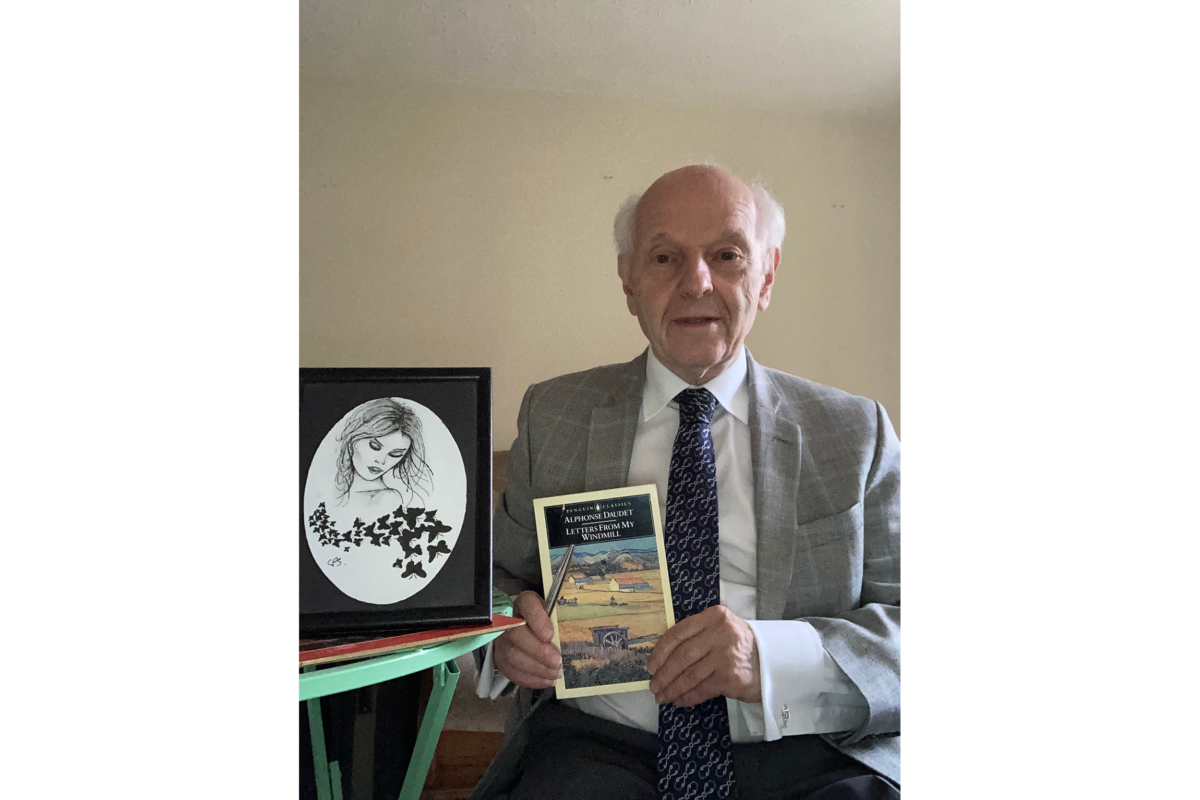Credit: The producer extends his gratitude and appreciation to the artist Chrissie Skelding for providing her beautifully evocative sketch LADY WITH BUTTERFLIES for this commissioned feature, which he dedicates to her.
“On the way down to the village from my windmill, you pass a farmhouse.…”
That is how Alphonse Daudet begins his evocative and poignant tale about broken love set in a small Provençal community. The Girl from Arles – L’Arlésienne – is a short story, based on a true event, in Daudet’s collection of cameos that he called Lettres de mon Moulin – Letters from my Windmill: fictional but lifelike pictures of mainly Provençal country life in mid 19th Century Southern France. In fact Daudet never owned a windmill there (despite tourist companies’ photographs!), and he never even rented one, but he often visited the area and he loved its scenery, its atmosphere, and its people. The Girl from Arles actually takes place in the small village of Fontvieille, 6 and a half miles North East of Arles. 150 years or so ago that length was a considerable distance in travelling time – and effort: in the region of a two hour walk. A young man in Fontvieille is heartbroken when his engagement to an entrancing young lady from Arles has to be called off: and suddenly that glittering city of his adored one seems more distant than another continent. The young man, Jan, turns into himself, and try what he may, he cannot forget his beloved – she haunts him day and night. Many evenings he walks from Fontvieille towards Arles until he sees the steeples of the city rising up against the sunset – and then he turns back home: he never goes further. Everything reaches a tragic culmination after the Feast of St Eloi (the 1st of December).
When Daudet was commissioned to adapt his story into a play for the Vaudeville Theatre in 1872, Georges Bizet was engaged to write incidental music in the form of miniature orchestral movements that were heard sometimes between scene changes and occasionally during the spoken dialogue. Some of these were very short, in the form of fragments, but some were more substantial. Economic and spacing limitations determined that Bizet could only be allowed the unusually small number of 26 players in his orchestra, with a small off-stage chorus as well – but far from inhibiting him, this arrangement inspired him to write music of extraordinary originality and rare intimacy, intensely capturing the story’s pathos.
The L’Arlésienne suites for full symphony orchestra that were subsequently arranged from the incidental music for the purpose of concert performances, first by the composer (No 1) and then by Ernest Guiraud (No 2), are famously popular, but the original music for the play is hardly if ever performed, inevitably so as the majority of it is very fragmentary. Unlike the full orchestra suites, the music for the play is very different in sentiment. For The Girl From Arles – A Visit to Provence, Jon Tolansky has made a special adaptation reading the original short story of Daudet and inserting parts of Bizet’s original music for the play at correctly appropriate places. He prefaces the production with a scenic introduction to Provence, and as a postscript he features three extracts from the well known L’Arlésienne suites for full orchestra.
About Host and Producer Jon Tolansky:
Formerly a principal in the Royal Opera House Orchestra, Jon Tolansky specialises in making documentary features on composers and performers for international radio and television organisations as well as global recording companies. These have included the BBC, RTE Lyric FM, the WFMT Radio Network, WQXR, the CBC, EMI Classics, Warner Classics, Decca Classics, Deutsche Grammophon Gesellschaft, SOMM Recordings, Andante, and VAI Records. He pioneered the first ever sets of documentary profiles on CD, for which he personally collaborated with acclaimed artists such as Grace Bumbry, José Carreras, José van Dam, Dietrich Fischer-Dieskau, Mirella Freni, Nicolai Gedda, Valery Gergiev, Angela Gheorghiu, Carlo Maria Giulini, Thomas Hampson, Marilyn Horne,Yevgeni Kissin, Yehudi Menuhin, Sir Antonio Pappano, Luciano Pavarotti, Ruggero Raimondi, Mstislav Rostropovich, Giuseppe di Stefano, Dame Joan Sutherland, and Jon Vickers. For Warner Classics he initiated a new brand called the Autograph series, consisting of biographical overviews of acclaimed artists’ careers in themed compilations devised with their collaboration and also including exclusive new recordings of them discussing their lives and the music they have performed. Additionally, for Warner Classics, Universal Classics, and SOMM Recordings he has produced retrospective CD, DVD and podcast documentaries with new material he has originated on Claudio Abbado, Ernest Ansermet, Sir John Barbirolli, Sir Thomas Beecham, Eduard van Beinum, Benjamin Britten, Maria Callas, Guido Cantelli, Sergei Diaghilev, Wilhelm Furtwängler, Herbert von Karajan, Erich Kleiber, Carlos Kleiber, Otto Klemperer, Serge Koussevitzky, Gustav Mahler, Riccardo Muti, André Previn, Sir Georg Solti, Dmitri Shostakovich, Leopold Stokowski, Igor Stravinsky, Dame Joan Sutherland, George Szell, and Bruno Walter, and for Warner Classics he produced a retrospective documentary as part of the 24CD set celebrating the Philharmonia Orchestra’s 75th birthday.
Read more about Jon Tolansky on the Our Producers page.
